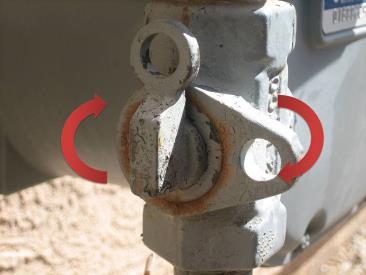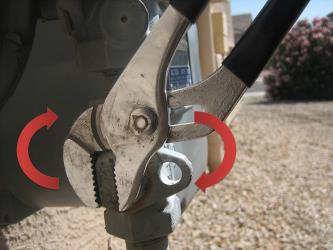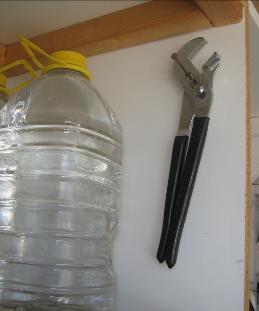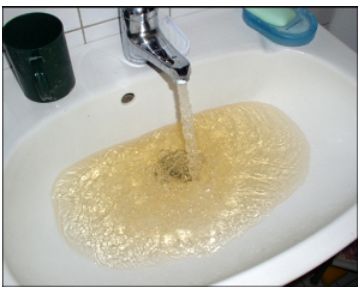|
Shutting Off Your Utilities |




|
In the event of a disaster, you may need to shut off one or all of the utilities in your home. Shutting off utilities may prevent further damage caused by disasters by potentially eliminating, gas leaks, flooding or other water damage, fires or electrocution to name a few. It is important for everyone in your home to know where these controls are located and how and when it is appropriate to shut them off. |
|
Turning Off Your Gas |
|
When to Shut off Your Gas
If you smell gas or hear a blowing or hissing noise, open a door or window and get everyone out quickly. Turn off the gas, using the outside main valve if you can, and call the gas company from a neighbor’s home. Do not use matches, lighters or open flame appliances. Do not operate electrical switches, including flashlights, because sparks could ignite gas causing an explosion. If you need light, use a chemical light stick. |
|
Do not shut off your gas unless you smell gas, hear gas escaping, see a broken gas line or if you suspect a gas leak. Once the gas is shut off at the meter, do not try to turn it back on yourself. If you shut off the gas, |
|
there may be a considerable delay before the utility company can turn your service back on. If the gas service shutoff valve is closed, the gas company or other qualified professional must perform a safety inspection before the gas service is restored and the appliance pilots are lit. Never attempt to turn the gas back on yourself. |
|
Where to Shut off Your Gas
The location of the gas valve can vary depending on the type of building and when it was built. The gas meter and gas service shutoff valve is usually located on the side or in front of the building. Because gas shutoff valves are wide ranging, talk to your |
|
landlord or gas company if you have difficulty finding it. Ask them for instructions on how to shut off your gas valve. |














|
How to Shut off Your Gas
Your gas can be turned off at the main gas service shutoff valve normally located near your gas meter. Using a crescent wrench, adjustable pipe wrench or other suitable tool, give the valve a quarter turn clockwise. The valve is closed when the holes line up (used for padlocks to keep the gas meter closed). Always keep a wrench in a designated area so it is easy to find and readily accessible. |
|
Turning Off Your Electricity |
|
When to Shut off your Electricity
If a disaster causes structural damage, or in the case of floods or potential cracks in the pipes providing natural gas to your home, you will want to turn off your electricity. Sparks may cause fires especially in the case of leaking natural gas. Electrocution may also occur. Where to Shut off your Electricity |
|
Locate your main electrical circuit box. It is often on the exterior of your home near the electric meter. However, it can be found in basements, closets or other locations in your home. Take the time to locate yours and make sure other family members know where to find it as well. How to Shut off your Electricity
|
|
When you open the circuit box, you will find one large breaker, this is the “main” circuit breaker and several smaller circuit breakers called “branch” circuit breakers. Always flip each branch circuit breaker into the off position individually before you flip the main circuit breaker. This will reduce the likelihood of power surges and electrocution. When you are ready to turn your power back on, do it in reverse order. While all the branch circuit breakers are off, turn on the main circuit breaker, then flip each branch circuit breaker to the “on” position individually. If you have a backup generator, solar panel array or backup batteries attached to your electrical system, follow the instructions outlined by the manufacturer or installer.
Turning Off Your Water When to Shut off your Water |
|
|
|
Following many disasters, water lines can crack or rupture. This can often lead to contaminated water entering the water lines. If left running, the contaminated water can enter your home’s plumbing. Shut off your water following emergencies involving ruptured or cracked water lines until you hear from authorities that it is safe for drinking. Also make sure your sewer system is functioning properly before using it. This will prevent home contamination, and possibly the contamination of the drinking water supply. Water can quickly become a precious resource following many disasters. It is important that all household members learn how to shut off the water if the need arises. Pressure changes and gravity may drain the water in your homes plumbing |
|
including your hot water heater and toilet tanks unless you trap it in your house by shutting off the water at the main. The reverse is also true, where a pressure buildup can cause backed-up water or sewage to exit your faucets or drains with “explosive results”.
Where to Shut off your Water
|
|
Turn off water at the main meter (usually close to the street) or at the water main leading into the house.
At the Meter: Usually in your front yard close to the street or sidewalk, you will find a box with the word “Water” on it or the name of your water company.
Entering the House: A second location to shut off the water to your home often exists at the point where the water main enters the house. A valve is often present here that is easy to get to and will still shut off water to the entire home.
|
|
At the Meter: When you open the meter box, you should see the water main valve. The valve can be easily turned using a water meter key which are available at your local hardware store in the plumbing or sprinkler section. Keep this tool readily available and make sure everyone knows where it is stored. A long Wrench will also work if no water key is available. Entering the House: Locate the shut off valve for the water line at the point where it enters your house. Make sure this valve can be completely shut off. It might be rusted open, or it may only partially close. Replace it if necessary. Shut off the valve by turning it counter-clockwise until it stops turning. |